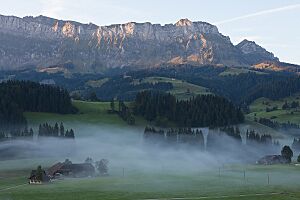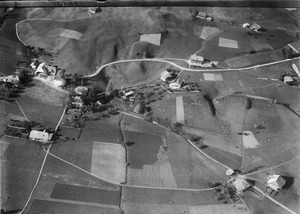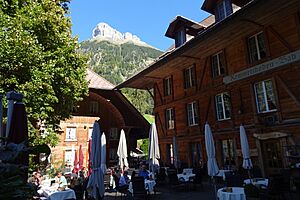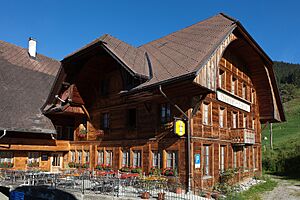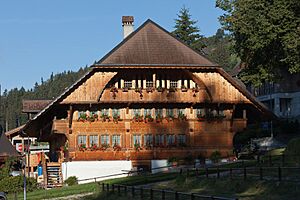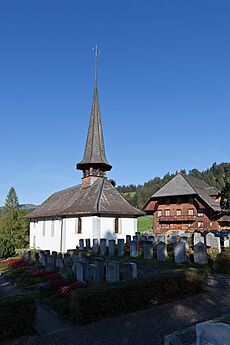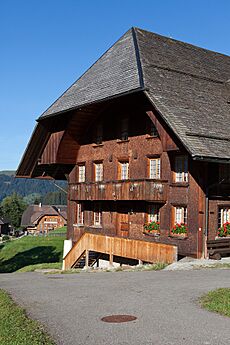Schangnau facts for kids
Quick facts for kids
Schangnau
|
||
|---|---|---|
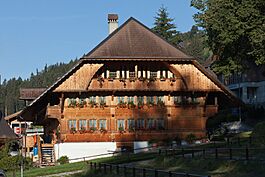 |
||
|
||
| Country | Switzerland | |
| Canton | Bern | |
| District | Emmental | |
| Area | ||
| • Total | 36.48 km2 (14.09 sq mi) | |
| Elevation | 630 m (2,070 ft) | |
| Population
(Dec 2020 )
|
||
| • Total | 918 | |
| • Density | 25.164/km2 (65.18/sq mi) | |
| Postal code |
6197
|
|
| Surrounded by | Eggiwil, Eriz, Flühli (LU), Habkern, Marbach (LU), Röthenbach im Emmental | |
Schangnau is a small town, also called a municipality, located in the Emmental area of the Bern canton in Switzerland. It is known for its beautiful natural surroundings.
Contents
History of Schangnau
Schangnau was first mentioned in old records in 1306. Back then, it was called Schoengowe.
In the 1300s, a family of knights from Sumiswald, who worked for the powerful Kyburg family, owned most of the village. Between 1363 and 1389, they sold their land to a local nobleman named Jost von Wald. His family then sold the village to the city of Bern in 1420.
In the late 1400s, both Bern and another city, Lucerne, wanted to control Schangnau. They were trying to make their borders bigger. In 1470, they signed a special agreement called a border treaty. This treaty officially made Schangnau a part of Bern.
Originally, Schangnau and a nearby village called Marbach were part of the same church area, or parish, of Trub. In 1524, these two villages decided to form their own parish. A few years later, in 1528, Bern changed its religion to Protestantism, and Schangnau followed.
A Protestant church was built in Schangnau in 1536. In 1594, Schangnau became its own separate church parish from Marbach. The village church was rebuilt in 1618. In the 1600s, there was a lot of religious tension in Switzerland. Because Schangnau was on the border with Catholic Lucerne, it became very important. After a war in 1656, Bern made Protestant Schangnau a special market town. This was to balance out the Catholic market town of Escholzmatt nearby.
For a long time, the local economy relied on farming crops in the valley. People also practiced seasonal alpine herding, which means moving cattle to high mountain pastures in summer. Transporting timber (wood) down the Emme River was also important. An alpine meadow called Bubenalp was mentioned in records even earlier than the village itself, in 1281. By the 1400s, much of the mountain forests were cut down to create more pastures for cattle.
A small glass factory opened in Schangnau in 1720. However, it was not as big or famous as a larger factory in Entlebuch. When the French invaded Switzerland in 1798, Schangnau became part of a new area called Oberemmental. After the French left and a new government was formed in 1803, Schangnau became part of the Signau district. It stayed there until 2009.
In the 1800s, new roads like Wiggen, Eggiswil, and Schallenberg Pass connected the village better. In 1875, a train station on the Bern-Luzern line opened, making travel even easier. However, not many factories or industries came to Schangnau. Most jobs were still in farming and the dairy industry. Even in 2005, more than half of all jobs in Schangnau were in agriculture. Only 14% were in industry.
A guesthouse called Kemmeribodenbad Inn opened in 1835 at the foot of the Hohgant mountain. This was the start of a small tourism industry in the area.
Geography of Schangnau
Schangnau covers an area of about 36.5 square kilometers (14.1 square miles). As of 2012, more than half of this land (53.3%) is used for farming. About 35.8% of the area is covered by forests.
A small part of the municipality (2.1%) has buildings or roads. About 1.1% is made up of rivers or lakes. The remaining 8.0% is land that cannot be used for farming or building, like rocky areas.
Schangnau is located at the highest point of any town in the Emmental region. It is found near where the Emme River begins. This river gives the whole valley its name. The municipality includes the main village of Schangnau, which is about 933 meters (3,061 feet) high. It also includes a smaller settlement called Wald, which is a hamlet (a very small village), and other scattered houses in the valley.
At the end of 2009, the old district of Signau, where Schangnau belonged, was closed. On January 1, 2010, Schangnau became part of the new Emmental administrative district.
Schangnau's Coat of Arms
The coat of arms for Schangnau has a special design. It shows a red background with a wavy silver (white) stripe across it. On top of this, there is a green fir tree with a gold (yellow) trunk and roots. Above the tree, there are three gold stars.
People of Schangnau (Demographics)
As of 2012, Schangnau has a population of 903 people. A small percentage (2.5%) of the people living here are foreign nationals, meaning they are not Swiss citizens. Between 2010 and 2012, the population slightly decreased. This was mostly due to more people moving away than moving in, and more deaths than births.
Most people in Schangnau (98.6% in 2000) speak German as their main language. A small number of people speak Serbo-Croatian (1.1%) or French (0.1%).
In 2008, the population was almost evenly split between males (50.3%) and females (49.7%). Most of the people living in Schangnau in 2000 (64.4%) were born there. Another 22.2% were born in the same canton (Bern). Only a small number were born in other parts of Switzerland (7.9%) or outside of Switzerland (2.9%).
In 2012, young people (ages 0-19) made up 22.8% of the population. Adults (ages 20-64) were 60.0%, and seniors (over 64) were 17.2%.
In 2000, there were 396 single people in Schangnau who had never been married. There were 440 married people, 60 widows or widowers, and 14 divorced people.
In 2010, there were 90 households with only one person. There were also 41 households with five or more people. Most apartments (79.3%) were lived in all year round. Some were used only for certain seasons (15.0%), and a few were empty (5.7%).
The chart below shows how Schangnau's population has changed over many years:

Economy and Jobs
In 2011, Schangnau had a very low unemployment rate of 0.7%. This means almost everyone who wanted a job had one. In total, 522 people were employed in the municipality.
Jobs are often grouped into three main types:
- Primary sector: This includes jobs that get raw materials from nature. In Schangnau, 258 people worked in this sector, mostly in farming. There were about 85 businesses in this area.
- Secondary sector: These jobs involve making things. 100 people worked in this sector, with 28 businesses. Many worked in manufacturing (making products) or construction (building things).
- Tertiary sector: These jobs provide services. 165 people worked in this sector, with 38 businesses. This includes jobs in sales, transportation, hotels, restaurants, and education.
In 2000, 49 workers came into Schangnau for their jobs, while 120 workers left Schangnau to work elsewhere. This means more people from Schangnau work outside the municipality than people from other places work in Schangnau. However, most workers (87.8%) lived and worked right in Schangnau. About 7.6% of working people used public transport, and 39.4% used a private car to get to work.
In 2011, a small part of the population (1.5%) received financial help from the government.
Important Buildings and Sites
The Krämer House in Schangnau is a very important building. It is listed as a Swiss heritage site of national significance. This means it is a special place that is protected because of its history and cultural value.
Religion in Schangnau
Based on a survey from 2000, most people in Schangnau (89.5%) belonged to the Swiss Reformed Church, which is a Protestant church. A smaller number (3.7%) were Roman Catholic. There were also some people who belonged to other Christian churches (like Orthodox) or other religions like Hinduism. About 1.65% of the population did not belong to any church.
Education in Schangnau
In Schangnau, about 52% of adults have finished high school, which is called non-mandatory upper secondary education. About 7.6% have gone on to higher education, like a university or a specialized college.
The school system in the Canton of Bern works like this:
- One year of optional Kindergarten.
- Six years of Primary school.
- Three years of mandatory lower Secondary school. In this stage, students are grouped based on their abilities.
- After lower Secondary, students can choose to continue their education or start an apprenticeship (learning a trade on the job).
During the 2012-2013 school year, 114 students attended schools in Schangnau. There were 25 students in German-language kindergarten classes. The primary school had 60 students in German classes. A small number of these primary students (3.3%) were not Swiss citizens, and 5.0% spoke a different language at home than German.
The lower secondary school had 29 students. Similarly, a small percentage (3.4%) were not Swiss citizens, and 3.4% had a different home language.
In 2000, 161 students attended school in Schangnau. Most of them (145) lived and went to school in the municipality. The other 16 students came from nearby towns. Also, 7 residents of Schangnau went to schools outside the municipality.
See also
 In Spanish: Schangnau para niños
In Spanish: Schangnau para niños





